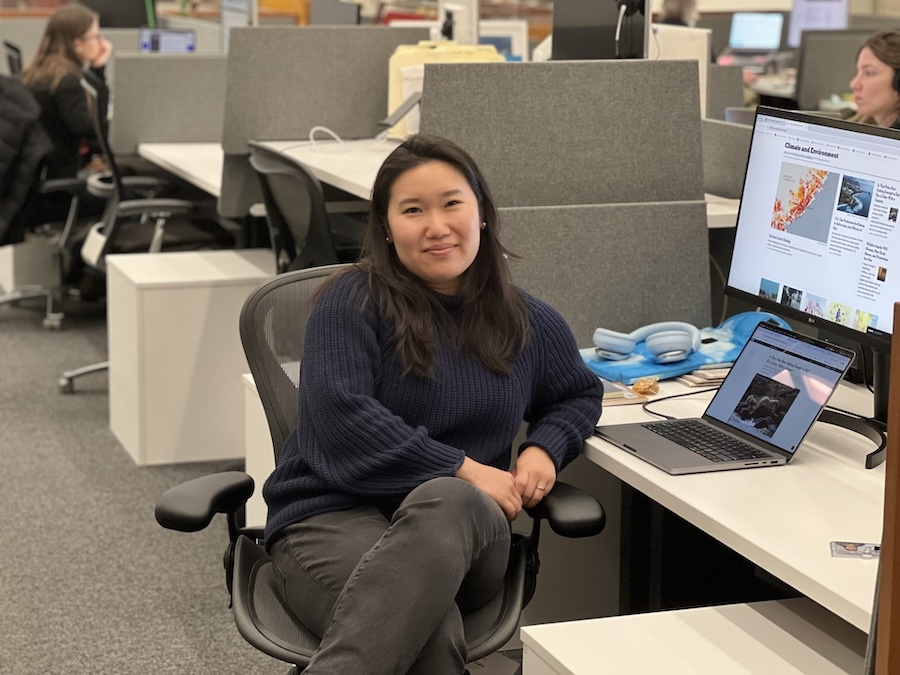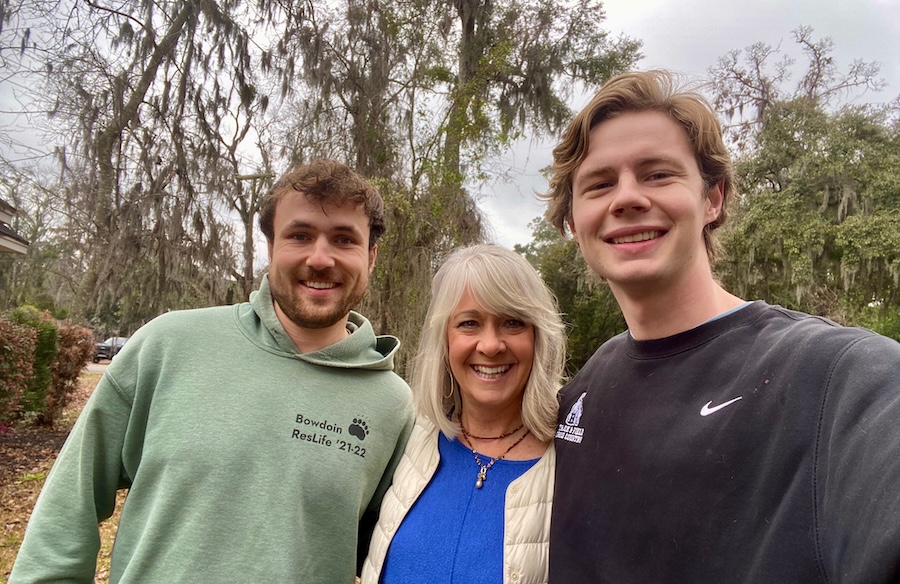Making a Difference at The New York Times
By Rebecca GoldfineCallie Ferguson ’15, a reporter for the Bangor Daily News, has a Local Investigations Fellowship from the Times to report on how Maine is treating juveniles in trouble with the law.
Last summer, Tenzin Tsagong ’16 joined the Opinions desk as an editorial assistant with the special projects team.
Katie Benner ’99, a member of the Bowdoin College Board of Trustees, has been a correspondent for The New York Times since 2015. She has written about the legal system, civil rights, national security, technology, and financial institutions, and won a Pultizer Prize in 2018 for her reporting on workplace sexual harassment.
Delger Erdenesanaa ’15 has a 2023–2024 Times Fellowship for early-career journalists.
We caught up with Erdenesanaa recently to hear what her days are like on the climate desk and what draws her to environmental reporting.
Breaking Climate News

When she graduated from Bowdoin in 2015 with a coordinated major in earth and oceanographic science and environmental studies, Erdenesanaa thought that perhaps she had read her last scientific article.
But in fact, reading academic journals is a now a regular part of her job at the New York Times.
Last June, Erdenesanaa started a one-year fellowship on the newspaper's climate desk. She reports on current scientific research, as well as the social, economic, and political angles of climate change.
Her earth science major at Bowdoin "has been helpful and has given me a head start," she said. Still, she added, the skills you need to be a competent journalist have a lot to do with curiosity and how you process unfamiliar information.
"You don’t need to have [my] background to report on this stuff," she said. "No matter what you’re covering, you have to learn about new topics every day."
Humility also helps, as well as a sensitivity to what readers require to absorb complex subjects. "I think you have to be careful you don’t assume you understand what you’re reading," she said. "I think it's important to ask scientists basic questions, even what sound like dumb questions."
"I always ask the authors to describe in their own words what they found, both to double-check my understanding and also because they can say it in a way that is more accessible to the general public reading the newspaper."
Journalism is Erdenesanaa's second career, following a foray into environmental policy. After Bowdoin, she worked at the World Resources Institute in DC for about four years. But she jumped track and earned a master's degree in science, health, and environmental reporting from New York University in 2021.
"I wanted to be able to think for myself about environmental topics and have that reflected in my work," she said, explaining the draw of journalism, "so, being able to research the issues I think are most important and am personally interested in, examining all sides of an issue, and putting out independent reporting rather than institutional messaging."
Emily Peterman, Bowdoin associate professor of earth and oceanographic science, said her former student never shied from tackling big questions head on. "Delger sought to distill complex topics into questions that she could work on, while always keeping sight of the larger picture," she added.
Erdenesanaa's writing gigs before the Times included Inside Climate News, where she was a fellow covering environmental justice, and the Texas Observer, where as a staff writer she wrote about the environment, climate, and related health and economic issues.
At the New York Times Building on Eighth Avenue, she mostly logs a 9:00 to 5:00 shift, while occasionally working flexible hours to schedule an interview with a scientist abroad or to cover breaking news about extreme weather events.
A perk of the fellowship is typing alongside journalists she admires and chatting with them about their work. Plus, the grind of putting out a daily paper—or, rather, a continuously updated online news site—has made her speedier and more efficient. "I think being in this daily newspaper environment has been great for learning good work habits. I have gotten faster, while still being accurate," she said. "It is good practice for every writer to get."
The office environment is quiet and intense. "It's not really like it is in the movies, with people shouting!" she said. "It is pretty quiet. People go into phone booths to do their interviews."
The hush, of course, masks the stress of the job. "Sometimes I wonder what my daily adrenaline is doing to my body," she joked. Still, "it is exciting," she said, and she's realized she loves being in a fast-paced workplace. Since she's expected to file shorter news stories—typically by mid-afternoon in time for editing—she can walk out the door at the end of the day relatively unburdened.
And that's helpful, because her day is not just fast, it's rigorous. At the moment, "I really feel I am using my brain close to full capacity, learning new stuff every day, and really thinking about what information is important for the public to know and how to present that info," she said. Journalism, she said, "is a rare career where you really get to use your core skills for 99 percent of the day and deal with very little bureaucracy, busywork, etc."
The job hits another high note for her: it's fulfilling, as she's "reporting on a topic that's very important for the world." That being said, she admits her beat is "a bit of a double-edged sword," since climate news is not very cheerful fodder.
Over the past months, she's produced a steady stream of stories on topics like Chile's forest fires, polar bear malnutrition, falling groundwater levels, dropping snow levels in the Northern Hemisphere, and so much more. Her stories are often featured prominently on the NYT app.
She makes a habit of reading the emails she receives from readers, as well as scanning their comments on her stories. "Unfortunately, because of the nature of what I cover, a lot of times the comments are people being very depressed about what they're reading. Sometimes that is how I feel, too. We're all in the same boat," she said.
But staying in touch with her readers helps her stay vigilant. "Reading the comments makes me question whether I am writing these stories and presenting them in the right way," she said. "It makes me think about how, overall, when it comes to climate coverage, what is the information people need."



